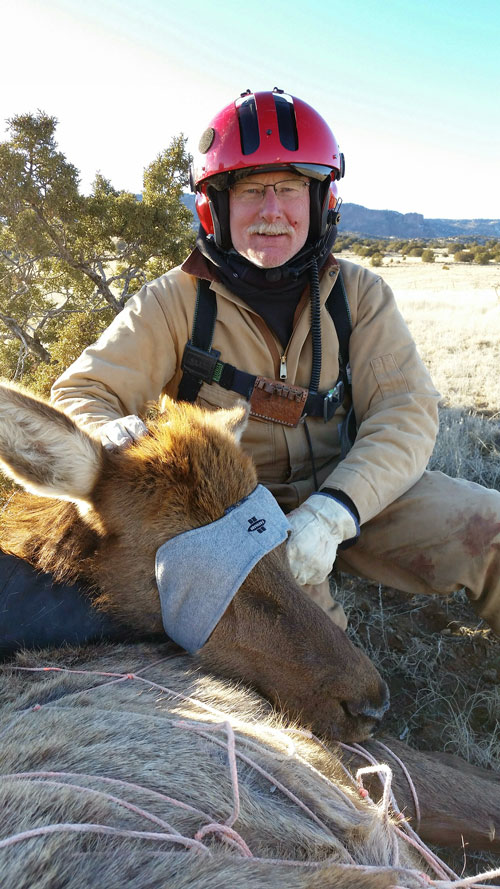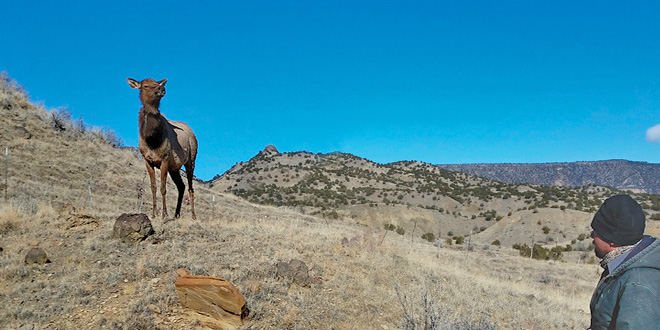Wildlife management can be challenging, especially when research data has yet to be collected and a theory needs
scientific support. While wildlife surveys can provide New Mexico Department of Game and Fish biologists with insight to population trends, they don’t provide answers when a decline is documented.
So, when biologists noticed a continued downward swing in elk calf survival around Mount Taylor, the question was: Why?
Determining a problem exists and understanding the cause are two different puzzles, and getting the pieces into place can be challenging. The task becomes more daunting when researchers have difficulty finding and monitoring the calves.
The only conclusions for which biologists are certain is that Mount Taylor elk herd numbers have been declining and calf survival rates have been low for more than five years.
“Scientifically, we’re just not sure what is happening,” said Nicole Quintana, big-game manager for Game and Fish.
In the summer of 2015, biologists captured 13 calves in the area and fitted each with an ear-tag transmitter, but the goal was to capture more.
“When you aren’t sure where exactly to look, calves can be extremely difficult to find,” Quintana said. “We planned to tag between 25-30. Thirteen simply isn’t a good sample size for developing a data-based management recommendation.”
In a little over six months, approximately 50 per-cent of those captured calves were dead. While that amount of mortality might sound high, it’s actually good.
“Based on our aerial surveys, we expected that number to be higher,” Quintana said. “This piece of information makes the mystery more puzzling.”
To find answers, it was time to consider other options. While researchers have suspicions, they want answers.
“Of the 13 calves, we saw some coyote predation, but the sample size was too small to draw any conclusions,” Quintana said. “We also would like to know if they suffer from bear, lion and possibly golden eagle predation. Or if another factor is at play.
“Right now we just aren’t sure and we’re looking for a larger number of calves to study.”
As it turns out, transmitters similar to those used to track wildlife can also inform researchers when cow elk give birth, providing locations where biologists can concentrate their efforts to begin monitoring larger numbers of offspring.
Game and Fish personnel headed to the Mount Taylor area with the goal of capturing adult females instead of calves.
In February, using a helicopter and a net gun, the crew managed to capture 40 cow elk and suffered just one mortality. Of those captured, 30 received vaginal implant transmitters and were fitted with collars.
The vaginal transmitters give off a special signal when the cows give birth and the collars help biologists find the location following birth. When the elk began giving birth in May and June, biologists traveled to the area and tagged the calves.

NMDGF photo by Nicole Quintana.
“We caught and tagged the calves so they can be remotely studied,” Quintana said. “This way we can monitor survival and investigate the causes of mortality.”
The project, partially funded by the Elk Enhancement Program — dollars received through the auction and raffles of two elk licenses is expected to continue for several years.
And it’s important to find answers. In a healthy elk population, surveys indicate about 40 calves for every 100 cows. In the Mount Taylor area, Game and Fish biologists have been document-ing 20 to 30 calves per 100 cows over the last few years.
“We’re looking forward to discovering what is happening to the calves,” said James Pitman, the elk program manager. “If we don’t have a good herd structure, it will directly impact future hunting opportunities.”
Pitman said a stagnant or dropping population can have long-term impacts for the herd.
“You don’t want to have these low calf-to-cow counts for a long period of time,” he said. “At 40 or more calves per 100 cows, the population can handle natural predation and remain healthy and growing. However, when the recruitment remains low for years, the population begins to decline.
“Whether it be predation, disease or old age, recruitment is no longer replacing the number of animals lost.”
Quintana and Pitman believe communication and cooperation has played an important part in the effort to find a cause for the low survival rates.
The area for the study includes a variety of private, public and tribal lands.
“We’re working with a lot of private landowners, federal agencies and tribal leaders who are also curious about what’s happening,” Pitman said. “I find it exciting. The cooperation has been great.”
Once extirpated from New Mexico, elk have been restored to the state’s landscape with the help of sportsman dollars. Conservation efforts such as the current research of low calf survival rates will play an important role in maintaining a healthy elk population for future generations to enjoy.
 New Mexico Wildlife magazine Conserving New Mexico's Wildlife for Future Generations
New Mexico Wildlife magazine Conserving New Mexico's Wildlife for Future Generations
